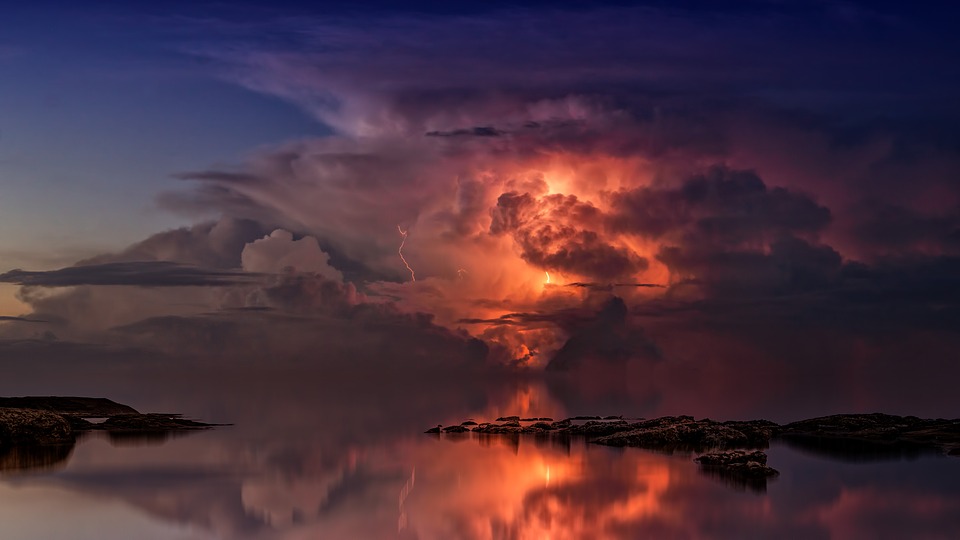Record-Breaking Weather
by Scott Dutfield · 27/02/2019

Discover where and when the elements have been at their most extreme
🌧Most rainfall
Imagine having to mop up after getting almost two metres of rain in one day. That’s what the citizens of the Cilaos, Reunion, had to do on 16 March, 1952 after an astonishing 1,870 millimetres of rain was believed to have fallen on the Indian Ocean island in just 24 hours. Yet that was just a shower compared with the 9,300 millimetres that was dumped on the residents of Cherrapunji, Meghalaya, India, throughout July 1861. Moreover, that came at the end of a 12-month period in which 26,461 millimetres poured on the town. Rain storms of this magnitude can occur in areas of mountainous terrain when moisture-laden air moves from a zone of high atmospheric pressure over the ocean to a region of low pressure over land.
❄️Heaviest snowfall
Snow can be fun in moderate quantities, but more than enough fell on Mt Shasta Ski Bowl, California, in early 1959 to build an entire army of snowmen. Between 13 and 19 February, 4.8 metres settled on the resort, a record amount for a single snowstorm in Northern America. However, the title of ‘snowiest place on Earth’ is claimed by Paradise in Mount Rainier National Park, Washington. On average, over 16.3 metres of snow blanketed the park every year between 1920 and 2011, with over 31 metres settling in the period from February 1971 to February 1972 alone. Snow falls when moisture in the air precipitates under sub-zero temperatures, forming tiny snowflakes that clump together and fall as snow. The heaviest snowfalls occur when air has passed over large bodies of water and an unstable atmosphere forces it to rise more quickly than usual.
☀️Longest heatwave
Meteorologists define heatwaves as periods when the temperature is above average for several consecutive days and nights. Such conditions are usually associated with high atmospheric pressure that compresses air near the surface, stifling circulation and preventing the formation of
clouds that would otherwise help block out some sunlight. Unsurprisingly, record-setting heatwaves tend to occur in desert regions. The hottest air temperature ever measured on Earth is 56.7 degrees Celsius. It was recorded at Greenland Ranch, Death Valley, California, on 10 July, 1913. Luckily for the local wildlife, though, that heatwave lasted less than a week. At around 37 degrees Celsius, the temperature in the world’s longest ever heatwave was balmy by comparison. Yet, that was small consolation to the residents of Marble Bar in central Australia who got no relief from the hot sun for 160 consecutive days from October 1923 to April 1924.
🌡Most dramatic temperature change
We say that people “change like the weather” if they display sudden mood swings and it’s an apt expression because the weather can be capricious.
The biggest temperature drop recorded in one day happened between 23 and 24 January, 1916 in Browning, Montana, when an influx of cold air sent the thermometer plunging from +7 to -49 degrees Celsius. The biggest swing recorded over a 24-hour period, though, happened in the town of Loma, also in Montana, between 14 and 15 January, 1972. The first morning was a frigid -48 degrees Celsius, but the next was a comparably pleasant +9 degrees. Native Americans have a term that describes the winds that can create these conditions: ‘chinook‘ or ‘snow eater‘. Coming inland from the ocean and flowing over the side of a mountain range, these winds replace cold Arctic air with warm, dry air.
🌪Widest tornado
The classic tornado is funnel-shaped with a narrow bottom, but this isn’t always the form these storms take, as the residents of El Reno, Oklahoma, found out on 31 May, 2013. At around 6pm local time, the El Reno tornado formed at an intersection about 15 kilometres southwest of the city. It soon began moving towards the town and rapidly increased in speed and size. Within 30 minutes it was moving at 80 kilometres per hour and had ballooned into a massive maelstrom of thunder and wind 4.2 kilometres across. Luckily for El Reno’s 18,500 residents, it largely missed the city as it tore across 16 kilometres of farmland, ripping up crops and flattening farm buildings before dissipating at about 6:45pm. Sadly, three American storm chasers weren’t so lucky: they were among eight people killed by terrifying winds that reached speeds of up to 340 kilometres per hour.
⚡️Longest-lasting tropical storm
Although its name is not among the most exotic in storm history, the 1994 version of Hurricane (and sometimes Typhoon) John holds the world record for not letting up. For 30 days between August and September it marched relentlessly across more than 13,000 kilometres of the north Pacific.
This article was originally published in How It Works issue 101, written by Mike Simpson
For more science and technology articles, pick up the latest copy of How It Works from all good retailers or from our website now. If you have a tablet or smartphone, you can also download the digital version onto your iOS or Android device. To make sure you never miss an issue of How It Works magazine, subscribe today!




